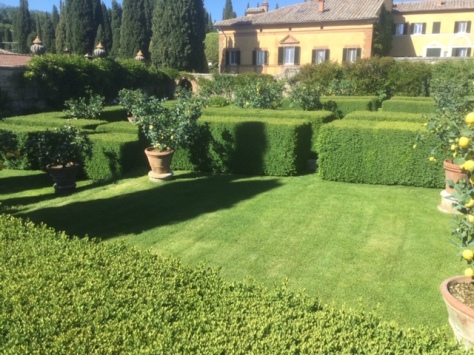by Sharleen Pratt, Master Gardener in Training
One thing that characterizes our gardens and landscapes from those in other parts of the world is our obsession with the lawn. The desire to have a smooth, green, flawless carpet has created an industry worth billions of dollars. I find that most serious gardeners have no time for the care and maintenance that a lawn requires. Like myself, they would rather be planting a new annual, perennial, or shrub.

Whether you are a big fan of lawns or not, it is important for us to understand how to best maintain a healthy lawn. Learning to do so in a sustainable way is critical as we move forward in our partnership with the environment.
What good is a lawn? Well, like all plants, turfgrass provides oxygen, helps filter pollutants from the air, and cools us in the summer through transpiration. It also provides a place for people to play a number of different sports, a place to walk, and creates a beautiful setting around a cemetery.
When thinking of your lawn, choose a seed that is appropriate for your region and your soil conditions. A good quality grass seed usually has a mixture of Kentucky Bluegrass, Fescue and Perennial Ryegrass. If you can get over the need for a grass only lawn, consider mixing your seed choice with some Dutch white clover. Clover provides nitrogen, stays green, and is drought tolerant.
 White clover in grass
White clover in grass
It is possible to seed in the spring, but usually the best time is in late summer (around August 15 to September 15) as bluegrass and fescue are cool season species. Also, fewer weeds germinate during this period of time. When over-seeding, be sure to water daily until the seedlings are at least 2 inches tall, then switch to deep watering once a week.
Fescues are more shade tolerant than bluegrass or ryegrass and germinate well in clay soils. Fescue is also more drought tolerant and are often vigorous growers. Ryegrass will act as a nurse grass for the slower germinating bluegrass. Its’ rapid germination will help to establish the lawn quickly and it produces little or no thatch.
Kentucky Bluegrass will give you that nice smooth texture with a dark green colour. Unfortunately, it doesn’t perform as well in heavy shade, has slower germination and prefers well drained alkaline soil. Therefore, with clay soil, it is best to have a higher percentage of fescue varieties and perennial ryegrass as part of the mixture.

Once established, your lawn will require a good management plan. To support the rapid growth in the growing season, your lawn will require a continuous supply of nutrition. Most lawn fertilizers are made up of nitrogen (N), phosphate (P) and potassium (K). Generally, nitrogen makes the lawn green, phosphorus produces healthy roots, and potassium builds hardiness (for more info check this link out).
In an ideal world, we would hope that the seed would benefit from an active population of earthworms, fungi, bacteria and a healthy supply of microorganisms. If you prefer to use organic lawn care, fertilize with 1 to 2 cm of compost each spring. This will help to feed the lawn naturally and supply the appropriate nutrients to the clay soil. A yearly practice of topdressing with compost will also help to increase the topsoil depth, especially if you live in a newer subdivision. The topsoil should be at a depth of at least 6 to 8 inches. This is often not the case when they build new homes.
During drought situations, let your lawn go dormant as it will grow and become green again once rain returns.
Always mow with your blades set high (2 ½ inches). This will help to crowd out the weeds and protect the grass roots from drying out. Be sure to maintain your mower blades to keep them sharp so they do not tear the grass blades. Mow only as often as needed to remove 1/3 of the grass blade at one time. Using a mulching mower and leaving the grass clippings on the lawn will help to return nitrogen to the soil.
It is important with clay soil to aerate and dethatch. Clay soils are often compacted and will benefit from removing soil cores and raking out thatch in the early spring to allow water drainage, increase air movement and supply nutrients.
The Peterborough Master Gardeners recently visited the Guelph Turfgrass Institute, established in 1987. It is part of the University of Guelph and they are dedicated to conducting quality research and providing accurate and timely information and education services in turfgrass science with a special emphasis on environmental sustainability and enhancement. The website has many good articles on lawn care, pest management, and irrigation.

